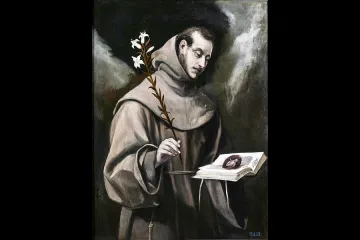CNA Staff, Jun 13, 2024 / 04:00 am
St. Anthony of Padua is one of the most famous saints in the Catholic Church, partly because of his connection to St. Francis of Assisi and also because he is popularly invoked as the patron saint of lost items.
St. Anthony’s feast day is today, June 13. But you may not be aware that there’s another important day of the year when St. Anthony is celebrated in Padua: Feb. 18, the day his tongue was removed.
Thankfully, this took place after the saint had died, during the first of two exhumations of the saint in the year 1263, three decades after his death.
Father Mario Conte, OFM Conv, one of the 50 friars who minister in the Basilica of St. Anthony in Padua, told CNA in 2022 that when the tomb was opened all those years ago, what was found was “really exceptional” — St. Anthony’s jaw and tongue appeared to be incorrupt.
According to Catholic tradition, saints who are miraculously preserved from decay give witness to the truth of the resurrection of the body and the eternal life in heaven that is to come.
“All the body had gone to ashes and bones basically, apart from the vocal apparatus, which was still wet and soft,” Conte explained.
“And so they took these parts, the tongue and the jaw, and they put them into some reliquaries. And if you go to the Basilica of St. Anthony, there is a chapel dedicated to the relics of St. Anthony and you will see them in that particular chapel.”
The Catholic Church has a long tradition of giving honor to relics, which are objects that have a direct association with the saints or with Christ himself. Relics are not worshipped but given honor — “venerated” — because of the saint’s love of and closeness to God. Those praying with relics often ask for that saint’s intercession.
The 1263 exhumation was carried out by the then-minister general of the Franciscans, St. Bonaventure, because the Franciscans were moving the saint’s body to a new and larger church. Conte said that when Bonaventure found the tongue, he said: “‘This is really a miracle. God wants us to know that St. Anthony was really the messenger of God’s love.’”
Today, the day that St. Anthony’s tongue was found is celebrated with Masses at the basilica that bears his name in Padua, northern Italy.
St. Anthony’s tomb was not to be opened again for more than 700 years — between January and February 1981. Conte described what it was like to be present for the second opening of St. Anthony’s tomb.
“In 1981, we decided to open St. Anthony’s tomb for the second time … I was young at the time,” Conte told CNA in 2022.
“That was when we found how the body of St. Anthony had been put inside a new coffin by St. Bonaventure,” he continued, and explained that additional relics from St. Anthony’s decayed body — pieces of the saint’s flesh, but not identifiable pieces of the body — were removed at this point and put into reliquaries.
Today, these relics of St. Anthony travel all over the world, making stops at parishes and dioceses where large crowds often come out to venerate them.
Who was St. Anthony?
Born in Lisbon, Portugal, in 1195, St. Anthony moved to Padua, Italy, after joining the Franciscan order. Anthony is known not only for his eloquent preaching and frequent rebukes of heretics but also for his loving care for the poor he encountered.
(Story continues below)
In 1224, St. Francis of Assisi gave Anthony permission to teach theology in the Franciscan order, which he did in several French and Italian cities while strictly following his Franciscan vows and preaching regularly to the people. Later, he dedicated himself entirely to the work of preaching as a missionary in France, Italy, and Spain, teaching an authentic love for God to many people who had fallen away from Catholic faith and morality.
Known for his bold preaching and austere lifestyle, St. Anthony also had a reputation as a worker of miracles. He died in 1231 amid poor health at the age of 36.
St. Anthony, a doctor of the Church, has his feast day celebrated June 13. In 2015, Pope Francis declared the Shrine of St. Anthony in Padua a minor basilica.






